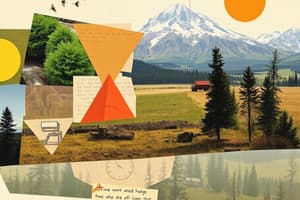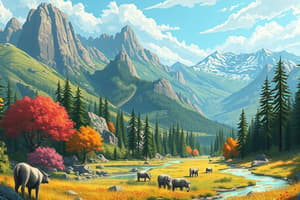Podcast
Questions and Answers
Pa lythyren yw'r prif lythyren olaf yn y rhestr?
Pa lythyren yw'r prif lythyren olaf yn y rhestr?
- x
- a
- z (correct)
- y
Pa un o'r rhestrau sydd â'r nifer mwyaf o eitemau?
Pa un o'r rhestrau sydd â'r nifer mwyaf o eitemau?
- Rhestr 31
- Rhestr 3
- Rhestr 36 (correct)
- Rhestr 20
Pellter nesaf ar ôl y llythyr 'v' yw?
Pellter nesaf ar ôl y llythyr 'v' yw?
- y
- s
- x
- w (correct)
Pa ymholiad a gynhelir ar ôl Rhestr 24?
Pa ymholiad a gynhelir ar ôl Rhestr 24?
Faint o eitemau sydd yn Rhestr 19?
Faint o eitemau sydd yn Rhestr 19?
Flashcards
Beth yw 'cynhwysiant'?
Beth yw 'cynhwysiant'?
Mae'r gair 'cynhwysiant' yn cyfeirio at y syniad y dylai pawb gael y cyfle i gyfrannu ac y dylai fod yna amrywiaeth o safbwyntiau a phrofiadau yn bresennol mewn bywyd cymdeithasol.
Beth yw 'cyfiawnder cymdeithasol'?
Beth yw 'cyfiawnder cymdeithasol'?
Mae 'cyfiawnder cymdeithasol' yn cyfeirio at yr egwyddor y dylai pawb gael cyfle cyfartal i lwyddo, waeth beth fo'u cefndir.
Beth yw 'amrywiaeth'?
Beth yw 'amrywiaeth'?
Mae 'amrywiaeth' yn cyfeirio at yr amrywiaeth o bobl, syniadau a phrofiadau mewn bywyd cymdeithasol. Mae'n cynnwys rhywedd, hil, oedran, diwylliant, a chyflwr corfforol neu feddyliol, ymhlith pethau eraill.
Beth yw'r pwysigrwydd o ddeall rhwystrau?
Beth yw'r pwysigrwydd o ddeall rhwystrau?
Signup and view all the flashcards
Beth yw'r pwysigrwydd o drafod amrywiaeth a chynwysiant?
Beth yw'r pwysigrwydd o drafod amrywiaeth a chynwysiant?
Signup and view all the flashcards
Study Notes
Unit 2 – Study Guide
-
Biomes and Aquatic Ecosystems: Know the characteristics of all biomes and aquatic ecosystems. If you want to use graphic organizers during the test, print them and submit them to the teacher by Wednesday, 12/11. Organizers will be returned on the test day.
-
Weather: Weather refers to the day-to-day conditions of Earth's atmosphere.
-
Climate: Climate describes long-term patterns of temperature and precipitation over many years.
-
Greenhouse Effect: The greenhouse effect is the process where energy enters Earth's atmosphere as light, and a portion is trapped as heat. Greenhouse gases absorb and re-radiate this heat, preventing it from escaping back into space.
-
Greenhouse Gases: Key greenhouse gases include carbon dioxide, methane, and water vapor.
-
Seasons: Earth's tilted axis and rotation around the sun cause the seasons. Different regions receive varying amounts of direct sunlight, leading to different temperatures.
-
Latitudinal Regions: Tropical regions are near the equator, temperate regions are between the tropics and the poles, and polar regions are near the poles.
-
Air Pressure and Density: Warm air is less dense than cold air and rises, creating low-pressure areas. Cold air is denser and sinks, creating high-pressure areas.
-
Pressure and Precipitation: Low-pressure areas often experience higher precipitation because rising air cools and condenses, forming clouds.
-
Mountains and Precipitation: Mountains force air to rise, cool, and condense, leading to precipitation on the windward side. The leeward side, sheltered from the wind, experiences a rain shadow effect and is drier.
-
Coriolis Effect: Earth's rotation causes winds to curve to the right in the Northern Hemisphere and to the left in the Southern Hemisphere.
-
Surface Winds: Trade winds move from east to west, westerlies from west to east, and polar easterlies from east to west.
-
Ocean Currents: Factors that influence ocean currents include solar heating, winds, salinity, and Earth's rotation.
-
Upwelling: Upwelling is the movement of cold, nutrient-rich water from the depths to the surface, often caused by winds.
-
El Niño/La Niña (ENSO): These cyclical climate patterns affect weather patterns globally. El Niño events lead to changes in high and low-pressure systems and affect upwelling patterns.
-
Photosynthesis: The process used by plants and other organisms to convert sunlight, water, and carbon dioxide into energy.
-
Chemosynthesis: A process where some organisms produce energy using chemicals instead of sunlight.
-
Food Webs: These show complex relationships between different organisms in an ecosystem.
-
Trophic Levels: These represent different positions in the food web, from producers (plants) to consumers (animals) to decomposers.
-
Invasive Species: Invasive species can disrupt the balance of ecosystems by competing with native species.
-
Water Cycle: The continuous movement of water between the Earth's surface and the atmosphere. Evaporation, transpiration, condensation, precipitation, runoff, and seepage are key parts of the cycle.
-
Carbon Cycle: The continuous movement of carbon through the environment through various processes. Photosynthesis, cellular respiration, and decomposition are crucial parts contributing to the cycle.
-
Nitrogen Cycle: The process of nitrogen moving through different forms in the environment, including the atmosphere, soil, and living organisms. Fixation, assimilation, ammonification, nitrification, and denitrification are parts of the cycle.
-
Phosphorus Cycle: The movement of phosphorus through the soil and living organisms. Weathering, assimilation, and decomposition are key parts of this cycle.
-
Wetlands: Wetlands can improve water quality and reduce runoff, potentially beneficial for farming.
Studying That Suits You
Use AI to generate personalized quizzes and flashcards to suit your learning preferences.




